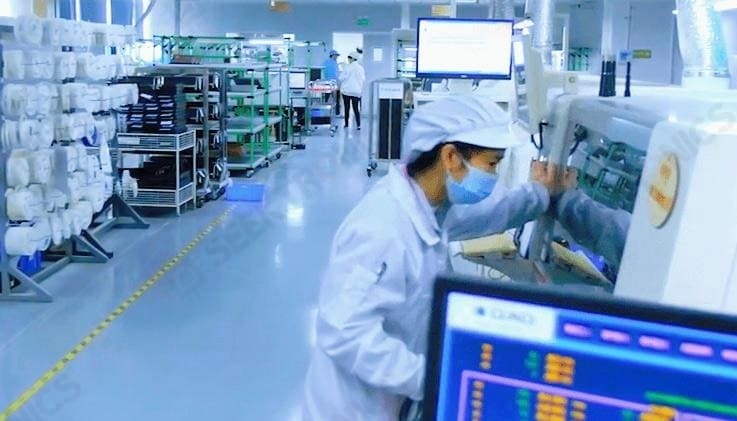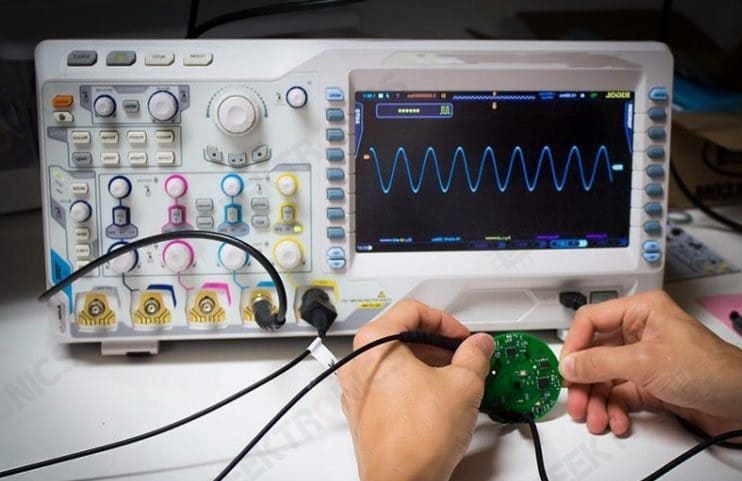Bare plate welding test procedure
1. After the circuit board is obtained, it is necessary to observe whether the circuit board circuit is damaged or not, and whether the welding plate is damaged or not.
2. Use a multimeter to measure whether there is short circuit between the power supply and the ground and between different power sources;
3, welding the first part of the power supply, and the power debugging successfully;
4. Weld the CPU and peripheral resistance, crystal oscillator and reset circuit again, and test the power supply and ground again after welding to avoid short circuit and thermal breakdown during welding;
Test after welding CPU: It is necessary to confirm that the crystal oscillator can start normally and reset normally. The program can be downloaded and simulated. When debugging, ensure that the corresponding IO port can be set.
IO port can be directly set to light the LED light.
5. Welding SDRAM and debugging.
6. Weld the serial port and connect it with the computer for serial port input and output debugging;
7. Welded other peripheral devices, combined with software for corresponding hardware debugging.

The test procedure for welded boards
Detection before power-on: After a circuit board is welded, it is usually not necessary to supply power directly to the circuit board when checking whether the circuit board can work normally. Instead, it is necessary to follow the following steps to ensure that there is no problem in each step before powering on:
l Whether the connection is correct: check whether the connection of the board is correct against the schematic diagram, and check one by one according to the circuit diagram;
l check the installation of components: diode polar capacitor and chip installation is wrong. Check whether the welding of each component has virtual welding.
l check the power interface and another short circuit: check the power supply, each level between the short circuit. Protection circuits such as self-restoring fuses should be added to the circuit design. The power supply can be designed with 0Ω resistance, which is not welded at the front line of the power supply test to avoid the abnormal level burning the chip of the rear unit.
Test after power-on: Check after power-on according to the following steps:
l power-on observation: do not rush to measure the electrical indicators after power-on but observe the circuit has no abnormal phenomenon, such as smoke phenomenon, there is no abnormal smell, hand touch integrated circuit packaging, whether hot and so on. In case of an abnormal phenomenon, the power supply should be turned off immediately, after troubleshooting the power check.
l Static test: step by step check whether the level state meets the expectation, and gradually resume welding 0Ω resistance. The debugging sequence of the subcircuit is generally carried out according to the signal direction, and the output signal of the previously debugged circuit is taken as the input signal of the latter level, so as to create conditions for the final tuning.
l Dynamic test: gradually add external input and output signals to debug all parts of the system. This step requires joint debugging with software.

Other points to note:
1. In the debugging process, it is necessary to observe and analyze the experimental phenomena carefully, and make good records to ensure the integrity and reliability of the experimental data.
2, the first level of welding test level, all can not be welded and then tested when the problem appears at which level is a difficult problem to find.
Dachang hardware test process: stability test
Important: HALT (Highly accelerated lif test) Highly Accelerated LIF test: board performance test.
HASS(Highly accelerated stress screen) : production-oriented adverse screening scheme.
In addition to the hardware unit of the board and the whole machine test. It will also carry out:
Small batch trial production, HALT experiment, environmental experiment, EMC experiment, thermal test.
HASS experiment will be carried out in the production link:
Special equipment for salt spray experiment, vulcanization experiment.
The whole structure will be: drop test, extrusion, distortion test.

HALT (Highly accelerated lif test) HALT (Highly Accelerated LIF Test) HALT is a process of discovering defects. It accelerates the exposure of defects and weak points of test samples by setting progressively stricter environmental stress, and then analyzes and improves the exposed defects and faults from many aspects such as design, process, and materials, so as to achieve the purpose of improving reliability. The most important feature is to set environmental stress higher than the design operating limit of samples. Thus exposing the failure time is greatly shorter than the time required under normal reliability stress conditions.
Environmental testing: Activities are undertaken to ensure that the functional reliability of a product is maintained during a specified life period and under all circumstances in which it is intended to be used, transported, or stored. It is to expose the product to natural or artificial environmental conditions to undergo its action, in order to evaluate the performance of the product in the actual use, transportation and storage environment, and analyze the influence degree of environmental factors and its mechanism of action.
EMC Experiment:
Thermal test:
HASS(Highly accelerated stress screen) : Highly accelerated Stress Screen:
HASS is applied during the production phase of the product to ensure that all improvements found in HALT are implemented. HASS also ensures that no new defects are introduced due to changes in manufacturing processes and components.
HASS contains the following contents
◆ Conduct pre-screening to eliminate hidden defects that may develop into obvious defects;
◆ Conduct detection screening to find out obvious defects;
◆ Fault analysis;
◆ Improvement measures.
General electronic product testing process:
(1) HASS Development
The HASS test plan must refer to the results obtained from the previous HALT test. In general, the operable limit of high and low temperature in the combined stress of temperature and vibration is reduced by 20%, and the vibration condition takes 50% of the failure limit G value as the initial condition of the HASS test plan. Then, according to this condition, the temperature and vibration combined stress tests are carried out to observe whether there is a fault in the measured object. If there is a fault, must first determine whether it is caused by excessive environmental stress, or by the quality of the measured object itself. In the case of the former, the temperature and vibration stress should be relaxed by 10% before the test. In the case of the latter, the current test conditions are valid. If no fault occurs, a further 10% of the ambient stress shall be tested.
(2) Proof-of-Screen
When creating a HASS Profile, two principles should be noted: First, it must be able to detect potential equipment failures; Secondly, the tests will not result in damage to the equipment or "internal injury". In order to ensure that the results obtained during the HASS test program phase comply with the above two principles, three test items must be prepared and some defects that are not manufactured or assembled according to the standard process, such as floating insertion of parts, air welding and improper assembly, must be made on each test item. Test each subject under the conditions obtained during the HASS pilot Project phase and observe whether the artificial defects on each subject can be detected to determine whether the test conditions should be tightened or relaxed to achieve the desired effect of the HASS Profile.
After the completion of the validity test, the HASS Profile should be tested 30 to 50 times with new test subjects under the adjusted conditions. If no damage occurs due to improper stress, then it can be judged that the HASS profile has passed the test in the planning verification stage and can be used for the Production of HASS. Otherwise, review and adjust the test conditions to obtain the best combination.
(3) Production HASS
Any Proof-of-Screen HASS Profile is considered to be a fast and effective quality screening tool, but it must be adjusted according to the customer's feedback after the use of the product. In addition, when the design changes, the test conditions are modified accordingly.





-20x20-20x20.png)

